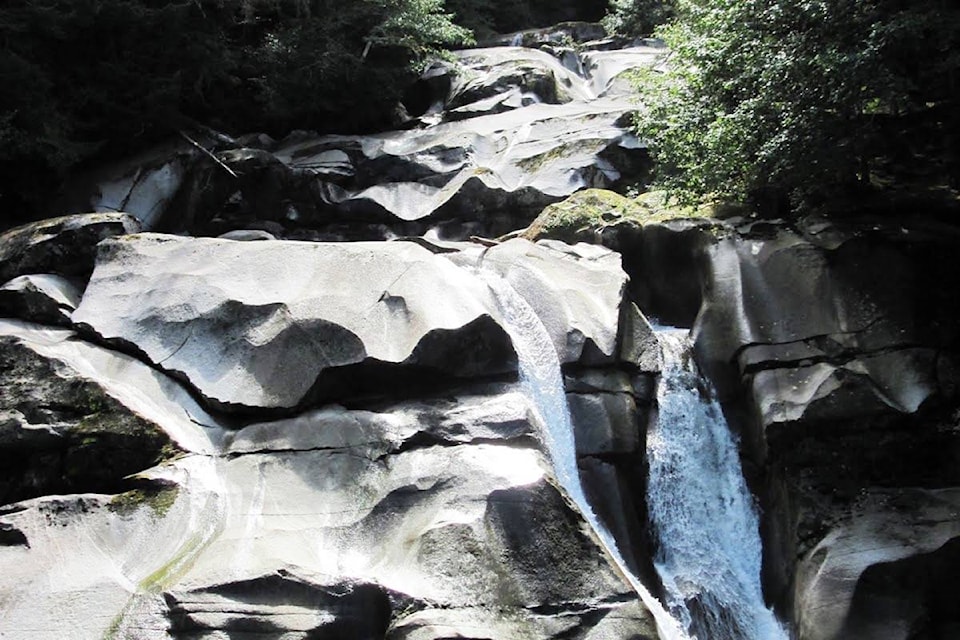Despite the usual, and not so usual setbacks (i.e. COVID-19), the Nuxalk Nation continues to work on plans for a run of river hydro-power at Nooklikonnik Creek.
Since last fall the team has been steadily pushing ahead with the project, with local coordinators Elijah Mecham and Vince Robinson working on the ground in partnership with Urban Systems consultants in Kamloops.
While still in its infancy, the potential for a run of river hydro-power at Nooklikonnik is promising. Sites have to meet certain criteria to even be considered for such a project, and the team looked at a total of 10 sites before narrowing it to three and eventually settling on Nooklikonnik as the best option.
The basic formula for successful hydro-power generation all comes down to head and flow. Head is the change in water levels between the hydro intake and the hydro discharge point. The amount of power, and therefore energy that you can generate is proportional to the head and the flow. The flow rate and how it varies over a year is an equally important parameter.
“Nooklikonnik has good potential for a variety of reasons,” said John Kenney, an Environmental and Sustainability Energy Professional with Urban Systems. “It has good head and flow, it’s located in an area of the Valley with meaningful power demand, has limited known constraints at this point, and it’s accessible relative to other sites of potential interest.”
Kenney explained that the project is coming closer to understanding some of the “critical success factors;” these include hydrology, fish habitat, geohazard risk, the interconnection the BC Hydro grid and most importantly community support from both Nation and the Valley residents.
“The key point is that Nuxalk continue to advance the project in a meaningful way,” said Coordinator Elijah Mecham.
Mecham said that, while the project continues to move forward, there have been challenges with community engagement due to COVID-19.
“We had planned to host some Open Houses but of course those may be on hold depending on what happens with COVID-19,” said Mecham. “However, people are welcome to get in touch anytime with questions, I can be reached by email at elijah@nuxalknation.ca or phone 250 799 5613.”
The main driver of the project is to move off the dependence of diesel generated power, and that still remains the main goal. Presently, Bella Coola relies on diesel generated electricity all year round, and its usage is especially high during the winter months.
“Fuel consumption amounts change from year to year depending hydro generation at Clayton Falls, weather conditions, and how much power customers use,” said Bob Gammer, BC Hydro Manager, Northern Community Relations in 2018. “The lowest annual diesel consumption in the last five years was 1,731,535 litres in the fiscal year ended on March 31, 2015. In the 12 months ending March 31, 2017 consumption was 2.36 million litres, with a low of 64,000 litres in August and a high of 392,000 in December and January
As Kenney explained, while BC Hydro wants to reduce diesel consumption, the company also wants to continue using their existing hydro-electric infrastructure at Clayton Falls. Therefore, they are only willing to buy a certain amount of additional hydroelectricity.
“Basically, BC Hydro will only buy a certain amount of power; offsetting only the diesel generation in the Valley, not Clayton Falls,” said Kenney. “So, we’ve taken this into consideration when planning the size of the project. You could theoretically produce a lot more power than the Valley needs, but we don’t want to oversize the project if the power can’t be used.”
Just to the south of Bella Coola the Wuikinuxv Nation has finished their own project: a 350-kilowatt hydro-diesel hybrid that will be constructed on the Nicknaqueet River, 2.3 kilometres southwest of the Wuikinuxv Village at Rivers Inlet. It is expected to replace 92 percent of electricity produced in Wuikinuvx by diesel generators.
Right now the team’s focus continues to be on the main factors that are critical to success. One of these is fish habitat, and the answer to that question continues to be explored.
“At present it appears as though there is no fish-bearing habitat at the site of the project,” said Mecham. “We are continuing to investigate the project area and we hope to have a definitive answer by Christmas about the presence of fish in the upper reaches of the watershed.”
The team also continues to analyze flow data from the site at Nooklikonnik as well as Saloompt; this information will be key to understanding it’s ability to displace diesel generated power from BC Hydro’s system.
“Early assessments of the project concept relied on synthetic data, but have been collecting site specific/empirical data to understand the hydrology of the watershed and what the project could potentially provide,” said Kenney. “BC Hydro will want to understand the details of the project’s production potential, so they can start to match the hydrology data to see how it can offset the diesel at certain times of the year.”
“There is also the question of how this project will integrate into the grid, and this is something BC Hydro will determine,” said Mecham. While progress is slow, it is steady, and local coordinators remain excited about the prospects of the project.
“We want to make sure people see the benefits of this project for the whole community,” Mecham continued. “Reducing our dependence on diesel is going to be good for everyone.”
